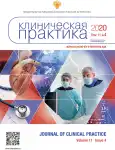Influence of the anterior chamber depth on the accuracy of the intraocular lens optical power calculation in short eyes
- Authors: Tsygankov A.Y.1, Pershin K.B.1, Pashinova N.F.1, Likh I.A.1, Akhrarov A.A.2
-
Affiliations:
- “Excimer” eye center
- Tashkent Medical Academy
- Issue: Vol 11, No 4 (2020)
- Pages: 41-48
- Section: Original Study Articles
- URL: https://journals.rcsi.science/clinpractice/article/view/34864
- DOI: https://doi.org/10.17816/clinpract34864
- ID: 34864
Cite item
Full Text
Abstract
Background. The calculation of the optical strength of the intraocular lens (IOL) in eyes with a short anterior-posterior axis presents significant difficulties due to non-standard anatomical parameters of the eye, including the anterior chamber depth. Aim: determination of the relationship between the anterior chamber depth (ACD) and the accuracy of the IOL optical power calculation in eyes with an axial length of less than 22 mm. Methods. A total of 86 patients (133 eyes) with a short axis — from 18.54 to 21.98 (20.7 ± 0.9) mm, were included in the study. Group I (n = 29, 40 eyes) consisted of patients with ACD of less than 2.5 mm. Group II (n = 30, 49 eyes) included patients with ACD from 2.5 to 2.9 mm Group III (n = 27, 44 eyes) included patients with ACD greater than 2.9 mm. The calculation of the IOL optical power was carried out according to the formula SRK/T, the retrospective comparison was performed according to the Hoffer Q, Holladay II, Olsen, Haigis and Barrett Universal II formulas. Results. In all three groups, there was an increase in UCVA and BCVA in the postoperative period. In group I, there were no significant differences when comparing MedAE for the six formulas (p < 0.05). The highest MedAE values (0.51 and 0.49 respectively) and the smaller MNE range (-0.03 ± 0.89 and -0.01 ± 0.97 respectively) are shown for the Haigis and Barrett Universal II formulas. In group II, the MedAE for the Haigis formula was 0.45, for SRK/T and Olsen it was 0.59 and 0.66. For the Haigis formula, the lowest MNE value (0.05 ± 0.69) is shown. In group III, no significant differences were found when comparing the average values of MedAE (р > 0.05). The lowest MedAE (0.17) and the best MNE values (-0.01 ± 0.58) are shown for the Haigis formula, while the SRK/T formula was characterized by the highest MedAE (0.37). In group II, the refractive index ±0.25 and ±0.50 D for the Haigis formula was significantly higher. Conclusion. For eyes with ACD of less than 2.4 mm, none of the formulas showed a significant advantage, while for ACD of 2.4–2.9 mm and higher, the use of the Haigis formula is recommended, and the SRK / T formula showed the worst result. The data obtained dictate the need to review the existing standards for calculating the IOL optical power in patients with short eyes depending on ACD.
Full Text
##article.viewOnOriginalSite##About the authors
Alexander Yu. Tsygankov
“Excimer” eye center
Author for correspondence.
Email: alextsygankov1986@yandex.ru
ORCID iD: 0000-0001-9475-3545
SPIN-code: 6476-4740
MD, PhD
Russian Federation, MoscowKirill B. Pershin
“Excimer” eye center
Email: kpershin@mail.ru
ORCID iD: 0000-0003-3445-8899
SPIN-code: 6019-3113
MD, PhD, Professor
Russian Federation, MoscowNadezhda F. Pashinova
“Excimer” eye center
Email: pashinovan@mail.ru
ORCID iD: 0000-0001-5973-0102
SPIN-code: 6212-9808
MD, PhD
Russian Federation, NovosibirskIvan A. Likh
“Excimer” eye center
Email: likh80@mail.ru
ORCID iD: 0000-0002-0002-3646
SPIN-code: 8759-8515
MD
Russian Federation, MoscowAbdusamad A. Akhrarov
Tashkent Medical Academy
Email: abdusamad.akhrarov@mail.ru
ORCID iD: 0000-0001-9260-8280
SPIN-code: 2125-8330
MD, PhD
Uzbekistan, TashkentReferences
- Gokce SE, Zeiter JH, Weikert MP, et al. Intraocular lens power calculations in short eyes using 7 formulas. J Cataract Refract Surg. 2017; 43(7): 892–897. doi: 10.1016/j.jcrs.2017.07.004.
- Першин К.Б., Пашинова Н.Ф., Цыганков А.Ю., Легких С.Л. Алгоритм выбора формулы для расчета оптической силы ИОЛ при экстремальной миопии // Точка зрения. Восток-Запад. — 2016. — №1. — С. 64–67. [Pershin KB, Pashinova NF, Tsygankov AIu, Legkikh SL. Choice of IOL optic power calculation formula in extremely high myopia patients. Point of view. East-West. 2016; (1): 64–67. (In Russ).]
- Olsen T.Calculation of intraocular lens power: a review. ActaOphthalmol Scand. 2007; 85(5): 472–485. doi: 10.1111/j.1600-0420.2007.00879.x.
- Першин К.Б., Пашинова Н.Ф., Цыганков А.Ю., и др. Биометрия при расчете ИОЛ как фактор успешной хирургии катаракты // Катарактальная и рефракционная хирургия. — 2016. — T.16. — №1. — С. 15–22. [Pershin KB, Pashinova NF, Tsygankov AIu, et al. Biometry in IOL power calculations as a factor of successive cataract surgery. Cataractal and refractive surgery. 2016; 16(1): 15–22. (In Russ).]
- Eom Y, Kang S-Y, Song JS, et al. Comparison of Hoffer Q and Haigis formulae for intraocular lens power calculation according to the anterior chamber depth in short eyes. Am J Ophthalmol. 2014; 157(4): 818–824.e2. doi: 10.1016/j.ajo.2013.12.017.
- Jeong J, Song H, Lee JK, et al.The effect of ocular biometric factors on the accuracy of various IOL power calculation formulas.BMC Ophthalmol. 2017;17(1):62.doi: 10.1186/s12886-017-0454-y.
- Shrivastava AK, Behera P, Kacher R, Kumar B. Effect of anterior chamber depth on predictive accuracy of seven intraocular lens formulas in eyes with axial length less than 22 mm. Clin Ophthalmol. 2019; 13:1579–1586. doi: 10.2147/OPTH.S217932.
- Hoffer KJ, Aramberri J, Haigis W, et al. Protocols for studies of intraocular lens formula accuracy. Am J Ophthalmol. 2015; 160(3): 403–405.e1. doi: 10.1016/j.ajo.2015.05.029.
- Yang S, Whang WJ, Joo CK. Effect of anterior chamber depth on the choice of intraocular lens calculation formula. PLoS One. 2017; 12(12): e0189868. doi: 10.1371/journal.pone.0189868.
Supplementary files









